Fellows---I have to agree with you about the laquer. (Hindsight is always 20/20!!!) However, it wasn't all the fault of the laquer. I couldn't get the solder to stick to the other machined brass bits that I had just machined earlier in the day from stock brass, which I know had no laquer on it. I think it may have been more of a compatibility issue between the Kester soldering paste and the brass. I know the Kester works on copper, but it wasn't doing anything for the brass, in terms of getting the solder to adhere to it. I did clean everything up and soak it in a jar of pickle juice mixed half/half with plain white vinegar overnight. Today I will try something else---Just not sure what yet. Does soaking stuff in the pickle juice do away with the need to use a flux?
You are using an out of date browser. It may not display this or other websites correctly.
You should upgrade or use an alternative browser.
You should upgrade or use an alternative browser.
Anybody want to guess---
- Thread starter Brian Rupnow
- Start date

Help Support Home Model Engine Machinist Forum:
This site may earn a commission from merchant affiliate
links, including eBay, Amazon, and others.
Brian,
I'm another one in the "too hot" camp. I did some brass a couple months ago using electronics solder. Had a hard time of it until the part started to cool off, then it stuck very well. When it was too hot the solder wouldn't stick at all, kinda like dripping water on a hot skillet, it just balled up. I also used an ancient paste flux that belonged to my Dad, don't know the name but it has to be about 50 years old.
I'm another one in the "too hot" camp. I did some brass a couple months ago using electronics solder. Had a hard time of it until the part started to cool off, then it stuck very well. When it was too hot the solder wouldn't stick at all, kinda like dripping water on a hot skillet, it just balled up. I also used an ancient paste flux that belonged to my Dad, don't know the name but it has to be about 50 years old.
- Joined
- Dec 2, 2008
- Messages
- 971
- Reaction score
- 9
Brian
Soft solder works at around 500 deg F so it doesn't need much heat. The problem is that brass is such a good conductor, it is hard to get the heat where it is needed and keep it there. If you need to clamp the parts, keep the contact between the clamp and the work as small as possible so the heat doesn't migrate into the clamp. I have used pointy wire spring clamps made out of bailing wire. It doesn't need much pressure. I use a small butane torch for brass. Use the smallest diameter wire solder that you can find or beat it thin with a hammer. Apply the heat to the heavier of two parts to be joined. Watch the flux, don't let it boil. Keep the solder out of the flame. When the flux melts, touch the solder to the joint. When the solder melts, it will be pulled into the joint, just like sweating copper joints. When the solder starts to flow, remove the heat but keep it close. You might have to add a little more heat to keep the solder wet while you flow it into a large joint. If the pieces are very heavy, I use two torches to bring the heat up to the melting point.
When I was much younger, I did some time as a refrigeration mechanic. Sweated a lot of copper that had to hold refrigerant under pressure. Brass is a lot easier because you don't have to do it in somebody's attic, surrounded by loose fiberglass insulation with the air temp approaching 110 deg F!
Jerry
Soft solder works at around 500 deg F so it doesn't need much heat. The problem is that brass is such a good conductor, it is hard to get the heat where it is needed and keep it there. If you need to clamp the parts, keep the contact between the clamp and the work as small as possible so the heat doesn't migrate into the clamp. I have used pointy wire spring clamps made out of bailing wire. It doesn't need much pressure. I use a small butane torch for brass. Use the smallest diameter wire solder that you can find or beat it thin with a hammer. Apply the heat to the heavier of two parts to be joined. Watch the flux, don't let it boil. Keep the solder out of the flame. When the flux melts, touch the solder to the joint. When the solder melts, it will be pulled into the joint, just like sweating copper joints. When the solder starts to flow, remove the heat but keep it close. You might have to add a little more heat to keep the solder wet while you flow it into a large joint. If the pieces are very heavy, I use two torches to bring the heat up to the melting point.
When I was much younger, I did some time as a refrigeration mechanic. Sweated a lot of copper that had to hold refrigerant under pressure. Brass is a lot easier because you don't have to do it in somebody's attic, surrounded by loose fiberglass insulation with the air temp approaching 110 deg F!
Jerry
I have cleaned up all the parts (Which was a far bigger pain than making the parts).I don't think that soaking the parts in a jar of pickle juice overnight did much except to make the parts sticky and smell like pickles!!! I have since washed them in a pan of plain water to get any of the pickle juice off. I am waiting for the local hobby shops to open so that I can see if they have any offerings in the line of flux and solder specifically for brass. It did take a great deal of work to make these parts, and I don't want to ruin them. I was using an oxy acetylene flame for my first attempt, and my reasoning was that since the brass ends for the tank are 5/16" thick, it would talke a lot of heat to bring them up to temperature. Next time around I will use a smaller tip size and less heat.
Don't want to get my hopes up too high but----I just resoldered 3 of the joints with a MUCH lower flame. and so far everything is acting like it should.---Good flow out and good "melding" of the solder to the brass. I couldn't wait for the hobby stores to open at 10:00. so I am using exactly the same materials that I used yesterday, only with much less heat.
Now this, boys and girls, is far closer to the results I had hoped to achieve yesterday. A combination of removing all traces of clear laquer from the recycled brass tube, and a much lower heat setting on my torch. Same solder, same solder paste. As soon as it cools down enough I will give it the old underwater bubble leak test, and then start a clean-up.
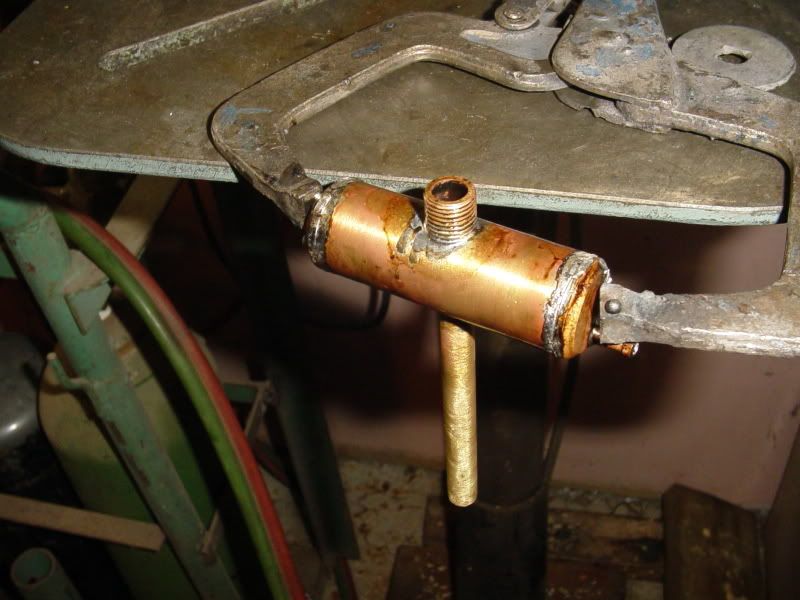
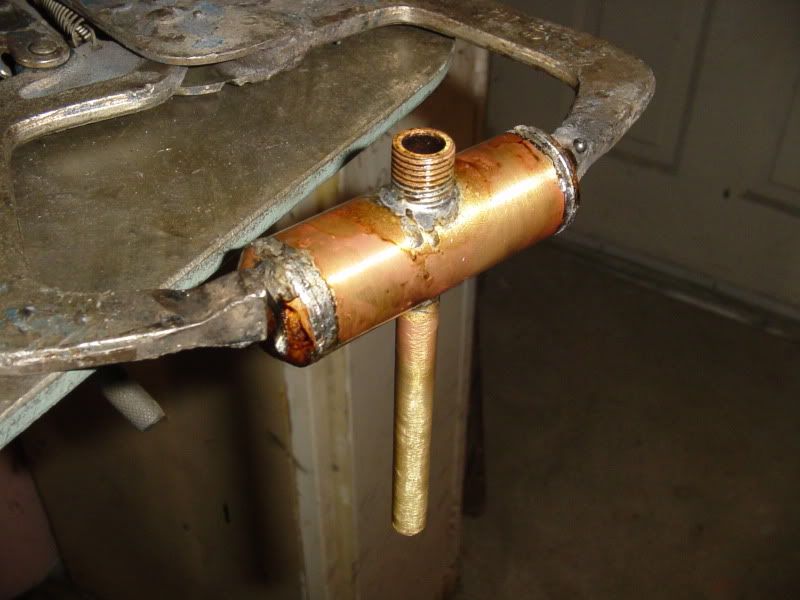



$519.19
$699.00
FoxAlien Masuter Pro CNC Router Machine, Upgraded 3-Axis Engraving All-Metal Milling Machine for Wood Acrylic MDF Nylon Carving Cutting
FoxAlien Official

$45.99
Sunnytech Mini Hot Air Stirling Engine Motor Model Educational Toy Kits Electricity HA001
stirlingtechonline

$109.99
AmTech300 - Boiler Treatment Professional Strength (Rust Inhibitor For Outdoor Wood Boilers)
Alternative Heating & Supplies

$99.99
AHS Outdoor Wood Boiler Yearly Maintenance Kit with Water Treatment - ProTech 300 & Test Kit
Alternative Heating & Supplies
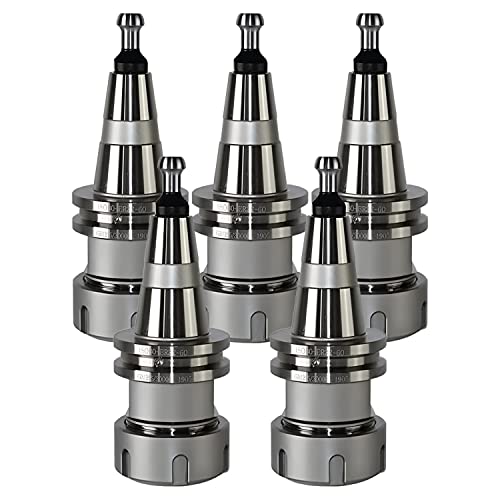
$99.90
$109.90
5PCS/Lot ISO30 ER32-60 Balance Collet Chuck G2.5 30000rpm CNC Tool Holder Stainless Steel Nickel plated With Pull Stud Woodworking Machine
david PA system

$443.98
TM NEXDYNAMI AT29618 Water Pump Compatible With/Replacement For John Deere 1020 1520 2020 300 301 400 401 440 440A 480 AT29618
VIVID MARKET CORPORATION

$54.46
Amana Tool - 46280 CNC 2D & 3D Carving 6.2 Deg Tapered Angle Ball Tip x 1/32 Dia x 1/64
Express Tool Supply

$39.99
$49.99
Sunnytech Low Temperature Stirling Engine Motor Steam Heat Education Model Toy Kit For mechanical skills (LT001)
stirlingtechonline

$156.90 ($1.40 / oz)
Replacement Combustion Chamber Kit, Burnham V8 and V8H, 1-6 Sec, 108136-01, 1129
Lynn Manufacturing

$40.02
$49.99
Becker CAD 12 3D - professional CAD software for 2D + 3D design and modelling - for 3 PCs - 100% compatible with AutoCAD
momox Shop
![DreamPlan Home Design and Landscaping Software Free for Windows [PC Download]](https://m.media-amazon.com/images/I/51kvZH2dVLL._SL500_.jpg)
$0.00
DreamPlan Home Design and Landscaping Software Free for Windows [PC Download]
Amazon.com Services LLC
Well there!!!! I'm happy with this. Perhaps not show quality, but its soldered. its shiny, and it doesn't leak. I can live with that.---Brian
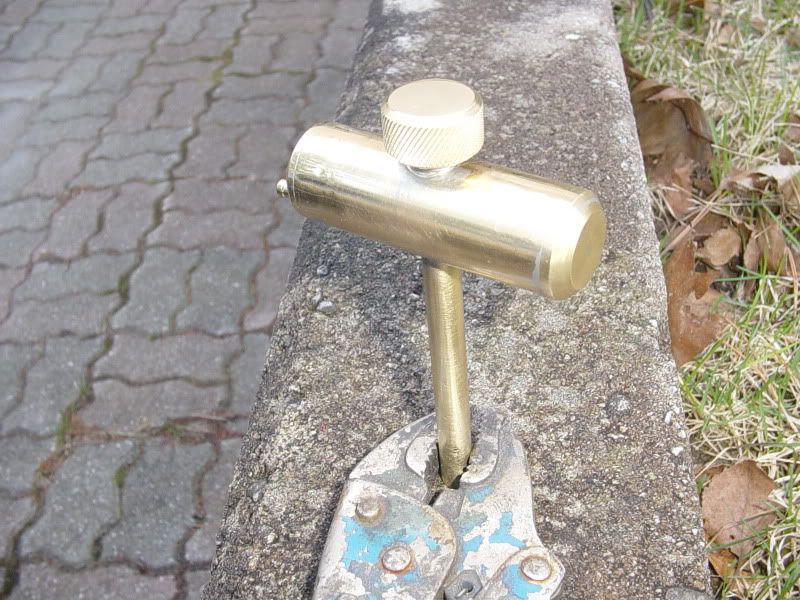
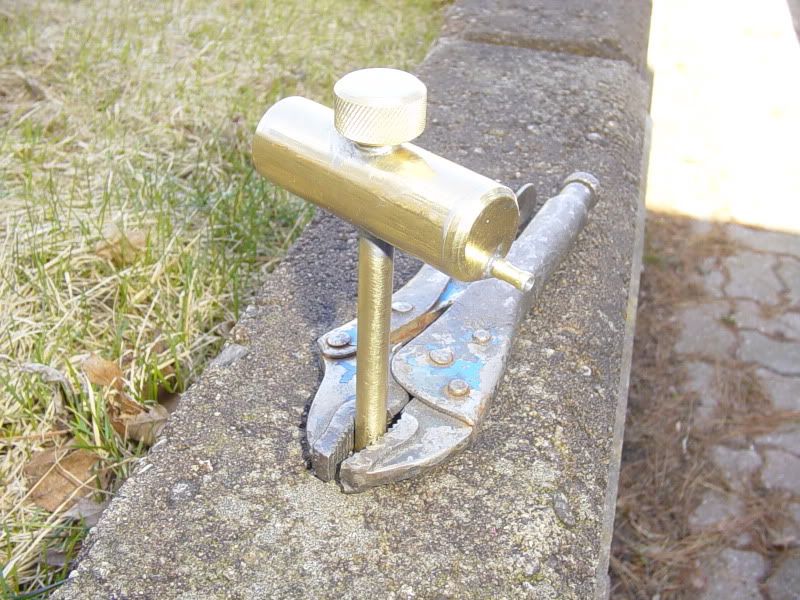


ariz said:and the knurling is perfect too
Ariz---Thats funny!!! ;D ;D---Every time I use that knurling tool, I never know what to expect. I see so many threads on here and on other machinists boards about people experiencing diificulties with knurling, and trying to calculate diameters and circumferances related to the pitch of thier knurling pattern. I just position one knurler roll above the part, one below, tighten up the squeeze nut on the arms, put the lathe into the lowest gear possible, say a short prayer to the machining Gods and turn on the lathe. If the pattern looks a bit shallow, I just tighten the nut a little more as the lathe is running. Thus far all my "knurls" have been outstanding.
zeeprogrammer
Well-Known Member
- Joined
- Mar 14, 2009
- Messages
- 3,362
- Reaction score
- 13
Nice posts on the soldering adventure. I've not done any soldering yet and pictures are a big help. Thanks.
Zee--I'm not sure what happened there, but I think the likeliest thing is that I had a stupid attack!!! I've been soldering things for years, with at least moderate success. Yesterdays fiasco was partly the fact that I never thought of the tube from my halogen lamp as being laquer coated. and mainly because of too hot a torch setting. I should have known better. If somebody takes some good from these posts, then I am very pleased. Soldering is not a terribly difficult thing, but like all things you have to THINK a bit before you pick up the tools.----Brian
radfordc said:Brian, is pickle juice a difference way of "pickling" soldered parts? The pickle solution I've read about is citric acid.
Charlie
Charlie---My best answer---I don't really know. I have heard of "pickling" brass to prepare it for soldering. I have heard advocates of citric acid, acetic acid, hydrochloric acid, and other dilute acids. White vinegar is acidic. A couple of months ago my wife was about to throw out the fluid left over from a jar of pickles, and I thought "Hey---I'll take that down to the shop and try it on some brass!!!" As I said, after an overnight soak in the pickle juice, there seemed to be no change in the appearance of the brass, other than that it was sticky and smelled of pickles. Oh well, nothing ventured, nothing gained. I don't think I would advise anyone else to try pickle juice. ;D
Hi all, a query about spirits of salts, I have an old bottle of this in my workshop, I believe it was used as a flux or cleaner for soft soldering, I know it is extremely corrosive,[left open for an hour and overnight my rulers were red rust the next day!] I use Duzall for my soft soldering, would anyone have any ideas as to what else this stuff m be used for. [spirits of salts is all that is written on thwe bottle]
cheers, southall.
cheers, southall.
Southall---I just did a very quick internet search for "Spirits of salts" and came up with the following
Hydrochloric acid was first discovered around 800 AD by the alchemist Jabir ibn Hayyan (Geber) and his contemporaries, by mixing common salt with sulfuric acid ("vitriol").[1][2] Jabir and contemporaries discovered many important chemicals, and recorded his findings in over twenty books, which carried his chemical knowledge of hydrochloric acid and other basic chemicals for hundreds of years. The 14th century description by Pseudo-Geber of the gold-dissolving aqua regia, consisting of hydrochloric acid and nitric acid, was of great interest to alchemists searching for the philosopher's stone.[1][2][3]
In the Middle Ages, hydrochloric acid was known to European alchemists as spirits of salt or acidum salis (salt acid). Both names are still deployed, notably in non-English languages, such as German: Salzsäure and Dutch: Zoutzuur. Gaseous HCl was called marine acid air. The old (pre-systematic) name muriatic acid has the same origin (muriatic means "pertaining to brine or salt"), and this name is still sometimes used. Notable production was recorded by Basilius Valentinus, the alchemist-canon of the Benedictine priory Sankt Peter in Erfurt, Germany, in the fifteenth century. In the seventeenth century, Johann Rudolf Glauber from Karlstadt am Main, Germany, used sodium chloride salt and sulfuric acid for the preparation of sodium sulfate in the Mannheim process, releasing hydrogen chloride gas. Joseph Priestley of Leeds, England prepared pure hydrogen chloride in 1772, and in 1818 Humphry Davy of Penzance, England, proved that the chemical composition included hydrogen and chlorine.[1][2][3]
Jabir ibn Hayyan, medieval manuscript drawing.During the Industrial Revolution in Europe, demand for alkaline substances increased. A new industrial process by Nicolas Leblanc (Issoundun, France) enabled cheap large-scale production of sodium carbonate (soda ash). In this Leblanc process, common salt is converted to soda ash, using sulfuric acid, limestone, and coal, releasing hydrogen chloride as a by-product. Until the British Alkali Act 1863 and similar legislation in other countries, the excess HCl was vented to air. After the passage of the act, soda ash producers were obliged to absorb the waste gas in water, producing hydrochloric acid on an industrial scale.[1][3][4]
In the twentieth century, the Leblanc process was effectively replaced by the Solvay process without a hydrochloric acid by-product. Since hydrochloric acid was already fully settled as an important chemical in numerous applications, the commercial interest initiated other production methods, some of which are still used today. After the year 2000, hydrochloric acid is mostly made by absorbing by-product hydrogen chloride from industrial organic compounds production.[3][4][5]
Since 1988, hydrochloric acid has been listed as a Table II precursor under the 1988 United Nations Convention Against Illicit Traffic in Narcotic Drugs and Psychotropic Substances because of its use in the production of heroin, cocaine, and methamphetamine.[6]
This fits right in with Maryaks advise to use dilute hydrochloric acid as a preperation for soldering in post #247.---Brian
Hydrochloric acid was first discovered around 800 AD by the alchemist Jabir ibn Hayyan (Geber) and his contemporaries, by mixing common salt with sulfuric acid ("vitriol").[1][2] Jabir and contemporaries discovered many important chemicals, and recorded his findings in over twenty books, which carried his chemical knowledge of hydrochloric acid and other basic chemicals for hundreds of years. The 14th century description by Pseudo-Geber of the gold-dissolving aqua regia, consisting of hydrochloric acid and nitric acid, was of great interest to alchemists searching for the philosopher's stone.[1][2][3]
In the Middle Ages, hydrochloric acid was known to European alchemists as spirits of salt or acidum salis (salt acid). Both names are still deployed, notably in non-English languages, such as German: Salzsäure and Dutch: Zoutzuur. Gaseous HCl was called marine acid air. The old (pre-systematic) name muriatic acid has the same origin (muriatic means "pertaining to brine or salt"), and this name is still sometimes used. Notable production was recorded by Basilius Valentinus, the alchemist-canon of the Benedictine priory Sankt Peter in Erfurt, Germany, in the fifteenth century. In the seventeenth century, Johann Rudolf Glauber from Karlstadt am Main, Germany, used sodium chloride salt and sulfuric acid for the preparation of sodium sulfate in the Mannheim process, releasing hydrogen chloride gas. Joseph Priestley of Leeds, England prepared pure hydrogen chloride in 1772, and in 1818 Humphry Davy of Penzance, England, proved that the chemical composition included hydrogen and chlorine.[1][2][3]
Jabir ibn Hayyan, medieval manuscript drawing.During the Industrial Revolution in Europe, demand for alkaline substances increased. A new industrial process by Nicolas Leblanc (Issoundun, France) enabled cheap large-scale production of sodium carbonate (soda ash). In this Leblanc process, common salt is converted to soda ash, using sulfuric acid, limestone, and coal, releasing hydrogen chloride as a by-product. Until the British Alkali Act 1863 and similar legislation in other countries, the excess HCl was vented to air. After the passage of the act, soda ash producers were obliged to absorb the waste gas in water, producing hydrochloric acid on an industrial scale.[1][3][4]
In the twentieth century, the Leblanc process was effectively replaced by the Solvay process without a hydrochloric acid by-product. Since hydrochloric acid was already fully settled as an important chemical in numerous applications, the commercial interest initiated other production methods, some of which are still used today. After the year 2000, hydrochloric acid is mostly made by absorbing by-product hydrogen chloride from industrial organic compounds production.[3][4][5]
Since 1988, hydrochloric acid has been listed as a Table II precursor under the 1988 United Nations Convention Against Illicit Traffic in Narcotic Drugs and Psychotropic Substances because of its use in the production of heroin, cocaine, and methamphetamine.[6]
This fits right in with Maryaks advise to use dilute hydrochloric acid as a preperation for soldering in post #247.---Brian
- Joined
- Dec 2, 2008
- Messages
- 971
- Reaction score
- 9
Thanks Brian, that's good to know.
Jerry
Jerry
Similar threads
- Replies
- 14
- Views
- 1K
- Replies
- 30
- Views
- 2K
- Replies
- 18
- Views
- 2K
























![[The Haynes GM, Ford, Chrysler Engine Performance Manual: The Haynes Manual for Understanding, Planning and Building High-Performance Engines (Haynes Techbook)] [Author: Haynes, Max] [August, 2008]](https://m.media-amazon.com/images/I/51x6eyiUHhL._SL500_.jpg)




















![TurboCAD 2020 Designer [PC Download]](https://m.media-amazon.com/images/I/51UKfAHH1LL._SL500_.jpg)





![MeshMagic 3D Free 3D Modeling Software [Download]](https://m.media-amazon.com/images/I/B1U+p8ewjGS._SL500_.png)



